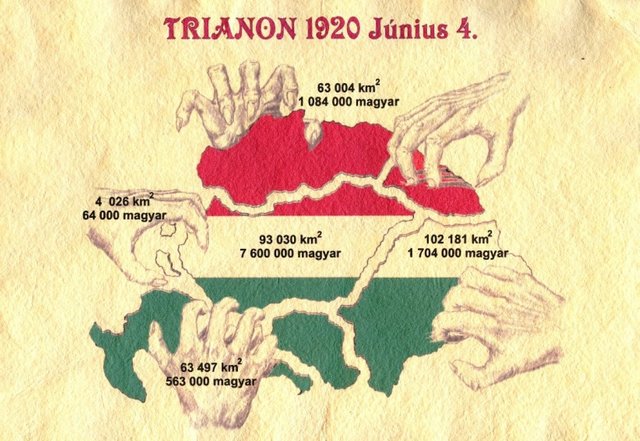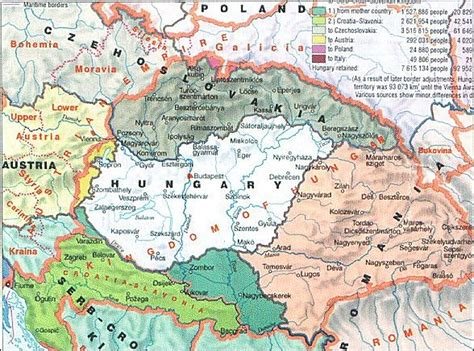In what ways did the post-Versailles order augment ethnic tensions? Part 1.

The question posed can be answered in at least two major ways. One would be to describe the processes that were triggered by the establishment of borders in regions that were ethnically complex and prove that the border changes concluding the Great War and wars of the early 1920's (called henceforth, for the sake of simplicity and at the cost of accuracy 'the Versailles order') either set ethnicities on a collision course or did nothing to avert it. A second way to proceed could be to present the ethnic tensions present before and during wartime and compare their intensity before and after the solidification of new borders. In this paper I tend to use the first method, as the second, while in my opinion technically more relevant to the question, which invites one to focus on pre-existant ethnic tensions, could imply that the creators of the post-war world were directly concerned with resolving ethnic conflict, which I don't think was a major matter for the diplomats of the age as opposed to creating a geopolitical balance. While the differences in the methods may be subtle, adopting one rather than the other would make my approach less comprehensive, thus I have decided to focus on the first while employing elements of the second where it is pertinent to illustrate not only by what means did new borders after World War I generate ethnic tensions but also how did the post-Versailles situation differ from the pre-war state of affairs.
A study of ethnic conflict after the First World War implies a global perspective, yet the enormous scope of such an approach, together with my ignorance of the contexts and particularities of other continents would render such an attempt deeply flawed, hence I confine myself to Europe. Furthermore the differentiation of an ethnic conflict from a conflict of states, religions or cultures is often challenging, therefore I choose to focus on these ethnic conflicts that have, amongst other factors in effect of the Versailles order (which remains to be proven), led to actions that are most convincingly elucidated as motivated by ethnicity. I write here for example of the political vision of Admiral Horthy, whom I shall use to illustrate the mentality of Hungarian elites, as in his person the connection between border changes and policy of an ethno-state are most visible. Another case I wish to explore is the Polish-Ukrainian animosity that stemmed from the creation of a Polish state and resulted in continual unrest and skirmish, developing into what I believe to be the final stage of ethnic conflict: ethnic warfare, where the distinction between civilian and soldier is more than fluid, a situation occurring most notably during the recent Balkan Wars.
The case of Hungary is most perplexing and I have selected it precisely for that reason, for it is evidence to the fact that it is hard to tell when a conflict between states becomes one of ethnicities and vice versa. The Versailles order paradoxically created a weak but sovereign Hungary in place of a powerful yet dependent one. The Hungarians as a people after the treaty of Triannon found themselves in possession of a state and yet with a third of ethnic Magyars living outside of its borders. This called for what Horthy ominously named “conducting ourselves like Balkan nations”. [1] It is important to remember that Horthy is in fact a good figure to choose to probe the political climate of the Hungarian elites: while radical army officers urged Horthy conspire with Luddendorf against communism and form a 'white international' in order to reinstate Great Hungary, rational statesmen argued for the continuation of negotiations with France to amend the Triannon Treaty. Both parties, opposed to each other strove to the same goal. In fact, at the time no political formation in Hungary, including even the communists, was content with the new borders. [2] I also believe that the regent had popular support: upon news of Charles IV's desperate attempt to restore the Habsburg monarchy, the following was said by a member of the regent's personal guard: “In the name of the Magyar nation we ask the Regent to remain true to the oath he has taken to the nation”. [3] We have no reason to believe that the Hungarian nation was anything short of determined and radically opposed to the Versailles order, and, in consequence, also hostile to the ethnic groups that inhabited countries to which Hungary lost territory.
While Habsburg Hungary was a guarantor of stability, balancing and keeping in check minorities within the empire, post-war Hungary, understood by me as a state controlled by what I can only call the 'will of the nation', was bellicose and flagrantly revisionist to the core. The book “Revisionist Hungary” written by a critic of the regime, Samuel Fenyes during Horty's regency presents an excerpt from a Hungarian schoolbook used from 1921 onwards in which the notion of ethnicity is not remotely present to describe the Hungarian nation. Instead, next to trustworthy figures showing that in fact Hungarians constitute 54.5% of the population, the notion of a political nation is introduced, together with the elucidation that no peoples in Panonia are in fact aboriginal, that the Great Hungary is a state occurring most naturally due to geographical and economic factors and that the nations inhabiting Hungary should dwell together harmoniously in one political organism. [4]
Naturally, such claims, while fairly coherent, were formed by Hungarians alone and were coupled with a more negative view of neighbouring people. It was maintained, for example, that Romanians developed no social classes but were a nation of cattle-growers who were not able even to urbanise the country they inhabited. [5] Captain Gyula Gömbös, later prime minister was reported to view a “national kingdom” without any “alien elements or alien influence” as “the only chance for a prosperous Hungary”. [6] Horthy reportedly had plans for some sort of an ethnic cleansing of Slovakia, yet he stopped Pál Prónay who intended to move north with troops loyal to him and like-minded officers. [7] On one hand pragmatism, on the other a maddening sense of injustice- these were, in varying proportions, the ingredients of any given Hungarian statesmen's mental make-up at the time. Stephen Csâky was correct when in 1921 he wrote: “The Hungarian people, standing alone in Europe, are ready to join hands with whomever will honestly help them.” [8] Hungary soon fell pray to skilful Nazi diplomacy and the merciless forces of geopolitics. Hitler talked of an answer to the Revisionsfrage that would be highly desirable and later used the 'Vienna awards' to tempt the Hungarian puppet government into adopting more anti-Semitic legislation. [9] It is clear that the Versailles order greatly augmented ethnic tension that, while not non-existent prior to the war, was far from being a defining factor of policy and an idée fixe for every ethnic Hungarian, whether stateless of not.
[1] - Thomas Sakmyster, Hungary's Admiral on horseback; Miklós Horthy, 1918-1944,
(New York, 1994), p. 63
[2] - Tibor Frank, 'Nation, National Minorities, and Nationalism in Twentieth - Century Hungary', in: Eastern European Nationalism in the Twentieth Century, ed. Peter Sugar, (Washington, 1995), p. 229
[3] - Peter Zadravecz titikos naploja, ed. Gyorgy Borsanyi, (Budapest, 1967), p. 211,
as quoted in: Sakmyster, op. cit., p. 93
[4] - Full excerpt: Samuel Fenyes, Revisionist Hungary, transl. Dora Kennedy,
(Miami Beach, 1988), p. 140-149
[5] - Samuel Fenyes, op. cit., p. 86-87
[6] - Miklós Horthy et al., The confidential papers of Admiral Horty, (Budapest, 1965), p. 15
[7] - Sakmyster, op. cit., p. 75
[8] - Stephen Csâky, 'The Responsibility of the Hungarian Nation in the War',
East European Problems, No. 14, (New York, 1921), p. 22
[9] - Jorg Hoensh, Der Ungarische Revisionismus und die Zerchlagung
der Tschechoslowakei, (Tubingen, 1967), p. 31;
George White, 'Territorial Dimensions of Hungarian Ethnic Identity',
Yearbook of the Association of Pacific Coast Geographers, Vol. 54 (1992), p. 39

If you donate 1 SBD or STEEM to @a-0-0 I will resteem your last post to over 72,500 followers on my 2 accounts @a-0-0 and @a-a-a